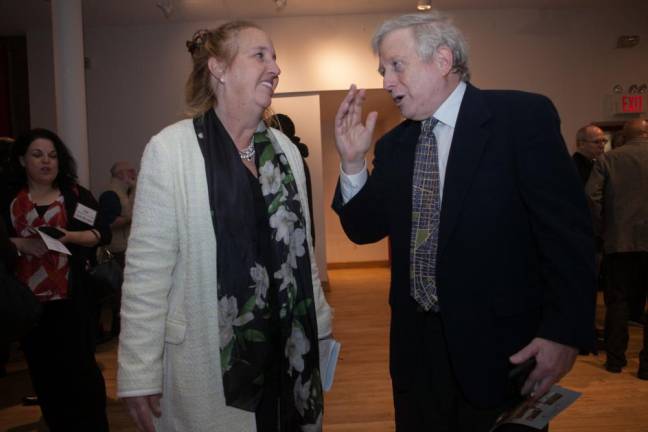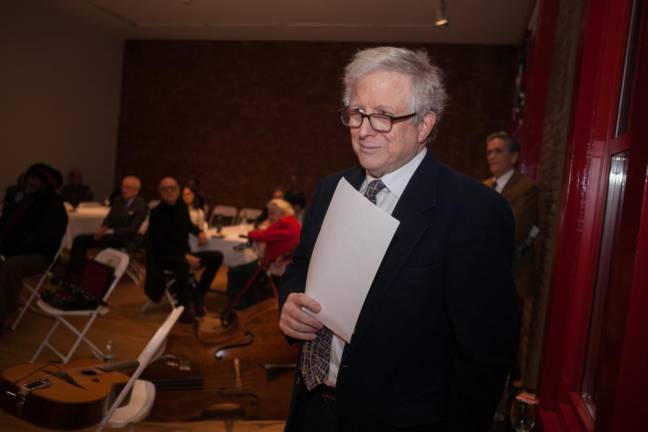Meet Your Manhattan Historian
Robert W. Snyder is taking on one of the city's most interesting and quirky posts


His first vivid memory of Manhattan came as a three-year-old in the late 1950s when he visited the city from suburban New Jersey with his family and entered an apartment building in Washington Heights – an experience he found “scary.” But Robert W. Snyder, the Bronx-born historian, scholar, researcher, academic, journalist, editor and author or co-author of five non-fiction books, all of them about New York City, quickly overcame those fears.
In fact, he wrote a 2015 book about the Heights, “Crossing Broadway,” and is co-author most recently of “All the Nations Under Heaven: Immigrants, Migrants and the Making of New York,” published by Columbia University Press. A former special projects researcher at Newsday, he’s currently working on a biography of legendary newspaper columnist Murray Kempton.
Now, Snyder, 64, is taking on one of the most interesting, unpaid and quirky posts the city has to offer: Manhattan borough historian. Appointed by Manhattan Borough President Gale Brewer, who terms his knowledge of history “unmatched,” he’s already settled into work in the Municipal Building. And after 20 years at Rutgers University-Newark, where he’s a tenured professor of journalism and American Studies, Snyder plans to retire in July 2020. We chatted about his agenda, the borough’s shifting landscape, the things he doesn’t know, nativism, immigration – even his favorite subway line.
How does one become a borough historian?
I was appointed by Manhattan Borough President Gale Brewer, who saw me speak at public events, especially at Coogan’s in Washington Heights, where I launched my book “Crossing Broadway: Washington Heights and the Promise of New York.”
It’s a unique position – almost entirely defined by the occupant. How do you envision the job?
I think of myself as an educator. My job is to help more people understand the depth of Manhattan’s history and the relationship between our borough’s past and present. I’m a professor, but I know that plenty of learning goes on outside classrooms. Over the years, I’ve created opportunities to teach history lessons in museum exhibits, radio and television documentaries, walking tours, books and op-eds. I’ll continue that practice. As borough historian, I’ll be seeking partners not just in schools at all levels, but also in museums, libraries and archives. And if bars and bookstores want to sponsor historical book talks, I’ll welcome that, too. Finally, I want to introduce journalists to a wide range of historians who can become informed sources for news stories. Most contemporary issues are best understood with a historical perspective. In today’s minute-by-minute news cycle, we need more voices that take a long view.
In our first conversation, you told me, “I want to make everybody a historian.” What do mean?
I want to give more people the tools they need – in books, online, in archives and elsewhere – to study the past. I also want to create more opportunities for people to gather in public forums to explore and discuss our borough’s history. We have a lot to learn from each other.
How do you accomplish that?
I’ll start by working to improve communications among everyone studying the history of Manhattan today, from people who work on their own to members of local historical societies to historians in universities, colleges, museums and libraries. Soon, I’ll be writing a lecture, “Manhattan 101,” that I can deliver around the borough. I hope to do a lot with social media, but there’s no substitute for face-to-face meetings. Ultimately, I’d like to create workshops around Manhattan where people can gather to study and write about everything from family history to neighborhood history to the history of their union, school, or house of worship.
New Yorkers have a weakness for historical trivia. Can you reconcile that with history?
We all walk around with bits of fact and folklore rattling around our minds. The job of a historian is to put those facts in context with research and analysis. One great thing about Manhattan is that evidence from the past is all around us, from Lenape rock shelters in Inwood to colonial graveyards downtown.
What don’t you know about Manhattan that you’d like to learn?
In an age of climate change, I want to learn more about how human action has shaped Manhattan’s ecology. Environmental history has never been more important.
The city was a different place in the 1980s when you got an M.A. and a Ph.D. at NYU and wrote a dissertation on vaudeville. There were low rents, great music – but muggings, too. Tell me about that era.
In the 1980s, I lived in Greenwich Village. I was enthralled by the intellectual and musical scene. I earned a meager salary as a graduate student, but it was enough to cover my rent – about $150 a month for a bedroom in a shared apartment on Thompson Street. But I was troubled by how crime, poverty, and bad housing undermined life in other neighborhoods. Even in the early 1990s I never anticipated the drop in crime or the rise in gentrification – more proof that historians should be wary about predicting the future.
From a historian’s perspective, has Manhattan changed for the better or worse?
The borough is safer and in some ways healthier than it used to be, and that’s great. But the rising cost of housing makes it harder for immigrants and young people to settle here. For centuries, Manhattan has benefited from the energy, vision and labor of people coming here to start a new life. If newcomers turn away because they can’t afford Manhattan rents, we’re in trouble.
Is there a political subtext to your latest book – “All the Nations Under Heaven: Immigrants, Migrants and the Making of New York” – in the Trump era?
New York has never been a peaceable kingdom, but over the centuries people of different nationalities, religions, races and ethnic groups have learned to get along here. We are far from perfect, but overall our history rebukes nativism and proves that all the world’s peoples can live together in one city.
We Manhattanites like to think of ourselves as enlightened, but did we ever have our own brand of nativists and “American Firsters”?
Nativism and racism have long histories here. In the middle of the 19th century, Irish Catholic immigrants, and to a lesser extent Germans immigrants, met bitter rejection. Street battles between Catholic and Protestant gangs were common, and conflicts between immigrants and natives shaped everything from policing to public schools to mayoral campaigns. As the 19th century gave way to the 20th, Jewish and Italian immigrants faced bigotry. Madison Grant, a prominent nativist who shaped the immigration restrictions of the 1920s, lived in Manhattan. And Puerto Ricans and African-Americans who came to Manhattan in transforming numbers after World War II confronted exclusion even though they were American citizens. The history of migration shows that inclusion has to be learned and fought for in every generation.
Now, the fun stuff: What’s your favorite neighborhood? Block? Street corner?
Favorite neighborhood: Greenwich Village, because even as it hyper-gentrifies it retains the spirit of the arts and dissent.
Favorite block: Grove Street in the Village, because it conveys the scale of 19th-century Manhattan.
Favorite corner: The Fort Tryon Park overlook in Washington Heights, where one glance takes in the beauties of nature and steel: The Hudson River, the Palisades and the George Washington Bridge.
What’s your favorite historical period?
The early 20th century, sometimes called the Progressive Era. People faced many of the issues that confront us today – inequality, vast corporate power, immigration, political corruption – with an energy and optimism that I admire. The muckrakers, radicals, reformers, union members and settlement house workers of that time are among the greatest of Manhattanites.
What’s your favorite subway line? And your least favorite?
My favorite: The A train, especially on the fast stretch between 125th Street and Columbus Circle. An enduring theme in my research is how mass transit, popular culture, the arts, politics and journalism knit a diverse metropolis into one city.
My least favorite: The 4/5 on the Lexington Avenue line, when delays sabotage my commute to Rutgers University-Newark.
Can Straus News readers get in touch with you if they have follow-up questions?
Absolutely! Anyone can write to me at rsnyder@manhattanbp.nyc.gov
invreporter@strausnews.com
"I want to create more opportunities for people to gather in public forums to explore and discuss our borough’s history. We have a lot to learn from each other." Robert W. Snyder, Manhattan borough historian